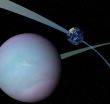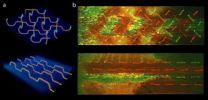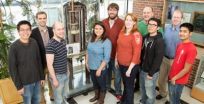(Press-News.org) Pivoting planets that lean one way and then change orientation within a short geological time period might be surprisingly habitable, according to new modeling by NASA and university scientists affiliated with the NASA Astrobiology Institute.
The climate effects generated on these wobbling worlds could prevent them from turning into glacier-covered ice lockers, even if those planets are somewhat far from their stars. And with some water remaining liquid on the surface long-term, such planets could maintain favorable conditions for life.
"Planets like these are far enough from their stars that it would be easy to write them off as frozen, and poor targets for exploration, but in fact, they might be well-suited to supporting life," said Shawn Domagal-Goldman, an astrobiologist at NASA's Goddard Space Flight Center in Greenbelt, Md. "This could expand our idea of what a habitable planet looks like and where habitable planets might be found."
The new modeling considers planets that have the same mass as Earth, orbit a sun-like star and have one or two gas giants orbiting nearby. In some cases, gravitational pulls from those massive planets could change the orientation of the terrestrial world's axis of rotation within tens to hundreds of thousands of years – a blink of an eye in geologic terms.
Though it might seem far-fetched for a world to experience such see-sawing action, scientists have already spotted an arrangement of planets where this could happen, in orbit around the star Upsilon Andromedae. There, the orbits of two enormous planets were found to be inclined at an angle of 30 degrees relative to each other. (One planet was, as usual, farther from the star than the other planet.)
Compared to our solar system, that arrangement looks extreme. The orbits of Earth and its seven neighboring planets differ by 7 degrees at most. Even the tilted orbit of the dwarf planet Pluto, which really stands out, is offset by a relatively modest 17 degrees.
"Knowing that this kind of planetary system existed raised the question of whether a world could be habitable under such conditions," said Rory Barnes, a scientist at the University of Washington in Seattle who was part of the team that studied the orbits of the two Andromedae planets.
The habitability concept is explored in a paper published in the April 2014 issue of Astrobiology and available online now. John Armstrong of Weber State University in Ogden, Utah, led the team, which includes Barnes, Domagal-Goldman, and other colleagues.
The team ran thousands of simulations for planets in 17 varieties of simplified planetary systems. The models the researchers built allowed them to adjust the tilt of the planetary orbits, the lean in the axes of rotation, and the ability of the terrestrial planet's atmosphere to let in light.
In some cases, tilted orbits can cause a planet to wobble like a top that's almost done spinning – and that wobbling should have a big impact on the planet's glaciers and climate. Earth's history indicates that the amount of sunlight glaciers receive strongly affects how much they grow and melt. Extreme wobbling, like that seen in some models in this study, would cause the poles to point directly at the sun from time to time, melting the glaciers. As a result, some planets would be able to maintain liquid water on the surface despite being located nearly twice as far from their stars as Earth is from the sun.
"In those cases, the habitable zone could be extended much farther from the star than we normally expect," said Armstrong, the lead author of the paper. "Rather than working against habitability, the rapid changes in the orientation of the planet could turn out be a real boon sometimes."
INFORMATION:
Odd tilts could make more worlds habitable
2014-04-15
ELSE PRESS RELEASES FROM THIS DATE:
Repeated self-healing now possible in composite materials
2014-04-15
Internal damage in fiber-reinforced composites, materials used in structures of modern airplanes and automobiles, is difficult to detect and nearly impossible to repair by conventional methods. A small, internal crack can quickly develop into irreversible damage from delamination, a process in which the layers separate. This remains one of the most significant factors limiting more widespread use of composite materials.
However, fiber-composite materials can now heal autonomously through a new self-healing system, developed by researchers in the Beckman Institute's Autonomous ...
Changes in processing, handling could reduce commercial fishing injuries
2014-04-15
CORVALLIS, Ore. – Handling frozen fish caused nearly half of all injuries aboard commercial freezer-trawlers and about a quarter of the injuries on freezer-longliner vessels operating off the coast of Alaska, new research from Oregon State University shows.
Many of those injuries and others aboard the two types of vessels could be prevented with the right interventions, and the research methods used in the study could help identify and reduce injuries and fatalities in other types of commercial fishing, said researcher Devin Lucas. His findings were published in the American ...
Potent, puzzling and (now less) toxic: Team discovers how antifungal drug works
2014-04-15
CHAMPAIGN, Ill. — Scientists have solved a decades-old medical mystery – and in the process have found a potentially less toxic way to fight invasive fungal infections, which kill about 1.5 million people a year. The researchers say they now understand the mechanism of action of amphotericin, an antifungal drug that has been in use for more than 50 years – even though it is nearly as toxic to human cells as it is to the microbes it attacks.
A report of the new findings appears in Nature Chemical Biology.
"Invasive fungal infections are a very important unmet medical ...
Long-term predictions for Miami sea level rise could be available relatively soon
2014-04-15
Miami could know as early as 2020 how high sea levels will rise into the next century, according to a team of researchers including Florida International University scientist Rene Price.
Price is also affiliated with the National Science Foundation's (NSF) Florida Coastal Everglades Long-Term Ecological Research (LTER) site, one of 25 such NSF LTER sites in ecosystems from coral reefs to deserts, mountains to salt marshes around the world.
Scientists conclude that sea level rise is one of the most certain consequences of climate change.
But the speed and long-term ...
Study: SSRI use during pregnancy associated with autism and developmental delays in boys
2014-04-15
In a study of nearly 1,000 mother-child pairs, researchers from the Bloomberg School of Public health found that prenatal exposure to selective serotonin reuptake inhibitors (SSRIs), a frequently prescribed treatment for depression, anxiety and other disorders, was associated with autism spectrum disorder (ASD) and developmental delays (DD) in boys. The study, published in the online edition of Pediatrics, analyzed data from large samples of ASD and DD cases, and population-based controls, where a uniform protocol was implemented to confirm ASD and DD diagnoses by trained ...
Astronomers: 'Tilt-a-worlds' could harbor life
2014-04-15
A fluctuating tilt in a planet's orbit does not preclude the possibility of life, according to new research by astronomers at the University of Washington, Utah's Weber State University and NASA. In fact, sometimes it helps.
That's because such "tilt-a-worlds," as astronomers sometimes call them — turned from their orbital plane by the influence of companion planets — are less likely than fixed-spin planets to freeze over, as heat from their host star is more evenly distributed.
This happens only at the outer edge of a star's habitable zone, the swath of space around ...
Vitamin D deficiency contributes to poor mobility among severely obese people
2014-04-15
Washington, DC—Among severely obese people, vitamin D may make the difference between an active and a more sedentary lifestyle, according to a new study published in the Endocrine Society's Journal of Clinical Endocrinology & Metabolism (JCEM).
The study found severely obese people who also were vitamin D-deficient walked slower and were less active overall than their counterparts who had healthy vitamin D levels. Poor physical functioning can reduce quality of life and even shorten lifespans.
Severe obesity occurs when a person's body mass index (BMI) exceeds 40. About ...
Osteoporosis risk heightened among sleep apnea patients
2014-04-15
Washington, DC—A diagnosis of obstructive sleep apnea may raise the risk of osteoporosis, particularly among women or older individuals, according to a new study published in the Endocrine Society's Journal of Clinical Endocrinology & Metabolism (JCEM).
Sleep apnea is a condition that causes brief interruptions in breathing during sleep. Obstructive sleep apnea, the most common form, occurs when a person's airway becomes blocked during sleep. If sleep apnea goes untreated, it can raise the risk for stroke, cardiovascular disease and heart attacks.
"Ongoing sleep disruptions ...
Can refined categorization improve prediction of patient survival in RECIST 1.1?
2014-04-15
In a recent analysis by the RECIST Working Group published in the European Journal of Cancer, EORTC researchers had explored whether a more refined categorization of tumor response or various aspects of progression could improve prediction of overall survival in the RECIST database. They found that modeling target lesion tumor growth did not improve the prediction of overall survival above and beyond that of the other components of progression. The RECIST Working Group includes the EORTC, the United States National Cancer Institute, and the National Cancer Institute of ...
Calcium score predicts future heart disease among adults with little or no risk factors
2014-04-15
LOS ANGELES – (April 15, 2014) – With growing evidence that a measurement of the buildup of calcium in coronary arteries can predict heart disease risk, Los Angeles Biomedical Research Institute (LA BioMed) researchers found that the process of "calcium scoring" was also accurate in predicting the chances of dying of heart disease among adults with little or no known risk of heart disease.
Previous studies had found that calcium scores were effective in predicting heart disease among adults with known heart disease risk factors, such as hypertension, diabetes, dyslipidemia, ...



